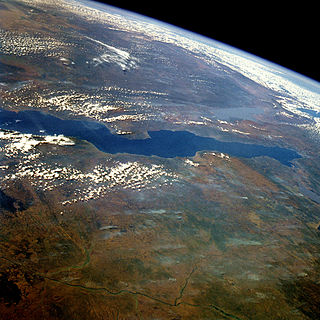
Lake Tanganyika is an African Great Lake. It is the second-oldest freshwater lake in the world, the second-largest by volume, and the second-deepest, in all cases after Lake Baikal in Siberia. It is the world's longest freshwater lake. The lake is shared between four countries—Tanzania, the Democratic Republic of the Congo (DRC), Burundi, and Zambia, with Tanzania (46%) and DRC (40%) possessing the majority of the lake. It drains into the Congo River system and ultimately into the Atlantic Ocean.

The Lukuga River is a tributary of the Lualaba River in the Democratic Republic of the Congo (DRC) that drains Lake Tanganyika. It is unusual in that its flow varies not just seasonally but also due to longer term climate fluctuations.

Kalemie, formerly Albertville or Albertstad, is a town on the western shore of Lake Tanganyika in the Democratic Republic of the Congo. The town is next to the outflow of the Lukuga River from Lake Tanganyika to the Lualaba River.
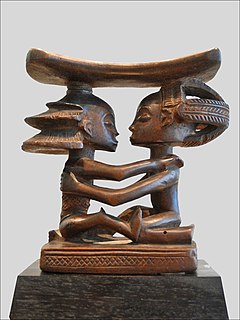
The Luba people or Baluba are an ethno-linguistic group indigenous to the south-central region of the Democratic Republic of the Congo. The majority of them live in this country, residing mainly in Katanga, Kasai and Maniema. The Baluba Tribe consist of many sub-groups or clans who speak various dialects of Luba and other languages, such as Swahili.
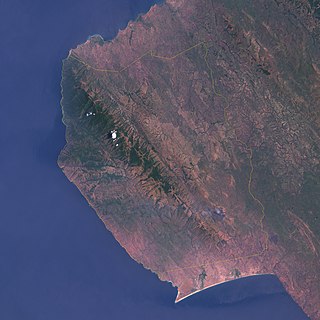
The Mahale Mountains are a mountain range in western Tanzania, on the eastern shore of Lake Tanganyika. They rise to 2,462 metres (8,077 ft) atop Mount Nkungwe.

The Albertine Rift is the western branch of the East African Rift, covering parts of Uganda, the Democratic Republic of the Congo (DRC), Rwanda, Burundi and Tanzania. It extends from the northern end of Lake Albert to the southern end of Lake Tanganyika. The geographical term includes the valley and the surrounding mountains.

MV Liemba, formerly Graf Goetzen or Graf von Goetzen, is a passenger and cargo ferry that runs along the eastern shore of Lake Tanganyika. The Marine Services Company Limited of Tanzania sails her, with numerous stops to pick up and set down passengers, between the ports of Kigoma, Tanzania and Mpulungu, Zambia.
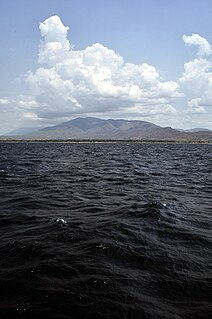
Mahale Mountains National Park lies on the eastern shore of Lake Tanganyika in Kigoma Region, Tanzania. Named after the Mahale Mountains range that is within its borders, the park has several unusual characteristics. First, it is one of only two protected areas for chimpanzees in the country. Mahale Mountains National Park harbours the largest known population of eastern chimpanzees and due to its size and remoteness, the chimpanzees flourish. It also a place where chimpanzees and lions co-exist. Another unusual feature of the park is that it is one of the very few in Africa that must be experienced by foot. There are no roads or other infrastructure within the park boundaries, and the only way in and out of the park is via boat on the lake.
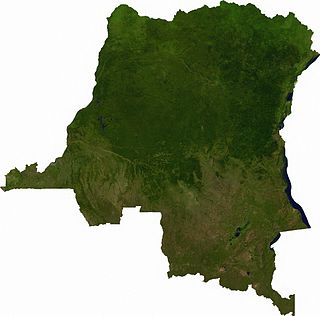
Articles related to the Democratic Republic of the Congo include:
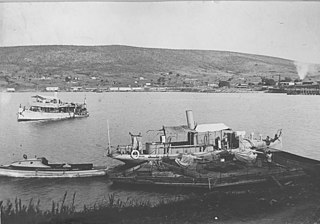
The Battle for Lake Tanganyika was a series of naval engagements that took place between elements of the Royal Navy, Force Publique and the Kaiserliche Marine between December 1915 and July 1916, during the First World War. The intention was to secure control of the strategically important Lake Tanganyika, which had been dominated by German naval units since the beginning of the war. The British forces – consisting of two motor boats named HMS Mimi and Toutou – were under the command of the eccentric Lieutenant-Commander Geoffrey Spicer-Simson. The boats were transported to South Africa and from there by railway, by river, and by being dragged through the African jungle, to the lake.

HMS Fifi was an armed screw steamer, captured from the Germans by Royal Navy units during the Battle for Lake Tanganyika, and used to support Anglo-Belgian operations on the lake and its surrounding areas. She had previously been operated by the Germans under the name Kingani named after the river Kingani.

The Kingdom of Luba or Luba Empire (1585–1889) was a pre-colonial Central African state that arose in the marshy grasslands of the Upemba Depression in what is now southern Democratic Republic of Congo.
Holoholo is a Bantu language of DR Congo and formerly in Tanzania spoken by the Holoholo people on either side of Lake Tanganyika. Classification is uncertain, but it may belong with the Takama group.
Katende, or Sungu-Katende, was a royal sacred village of the Kingdom of Luba. It was adjacent to the village of Kabondo. Katende is on the upper Lomami in the Lualaba region in the Democratic Republic of the Congo.
Ilunga Sungu was a ruler (Mulopwe) of the Kingdom of Luba in what is now the Katanga Province of the Democratic Republic of the Congo. Based on oral records, he ruled from some time around 1780 to around 1810.
The Hemba people are a Bantu ethnic group in the Democratic Republic of the Congo (DRC).
The Tumbwe people are a Bantu ethnic group living mostly in Tanganyika District of the Democratic Republic of the Congo.
The Sanga people are an ethnic group that lives mostly in the Katanga Province of the Democratic Republic of the Congo.
The people who currently identify themselves as Basimba or BaShimba for many and Musimba or MuShimba for singular are a Bantu speaking community in Uganda. Before the 13th century they maintained a shared identity as Basimba, also defined in Swahili as "big lion," associated with either these people or the place which they came from.
The Goma, who also refer to themselves as Al ghamawiyyun in Arabic, are a tribe in the Kigoma Region in western Tanzania. They are a contingent of the Bantu tribe who are more commonly found in Tanzania and present-day Democratic Republic of Congo who migrated from the western shore of the Lake Tanganyika in Democratic Republic of Congo with origins from Sudan. They are the first group of the Bantu tribe to ever cross the Lake Tanganyika and also the first group to reside in the Urban District of Kigoma as its inhabitants. Following the Wagoma were Niakaramba (Kwalumona) from Cape Karamba and then Wabwari from Ubwari peninsula. The Kwalumona merged within Wabwari, identified themselves as Bwaris and settled north of Wagoma in Kigoma before resettling in Ujiji and its environs, where they formed a tribal Confederacy in Ujiji known as Wamanyema. The Wagoma crossed the lake early due to their invention of dug-out canoes mitumbwi ya mti mmoja curved from Mivule trees of Ugoma mountains from western shore of the Lake.













